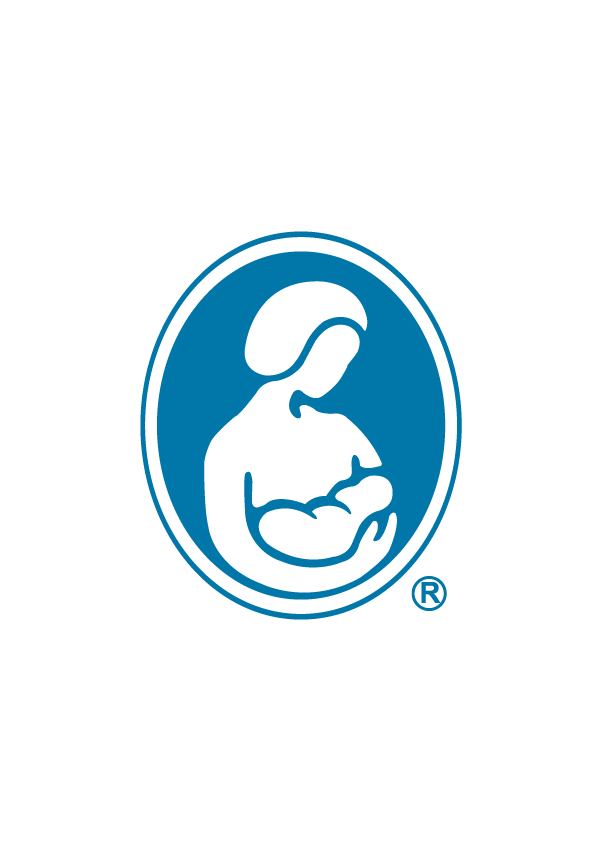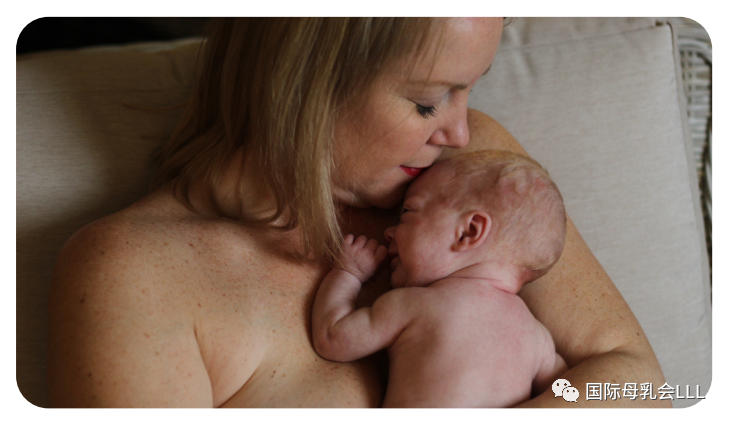点击上方国际母乳会LLL 设为星标,获取哺乳信息

图|国际母乳会中国图片库
正确、较深的含乳和有效吸吮的清单
婴儿的下巴紧贴着乳房
婴儿的嘴巴张得很大,上下嘴唇都外翻没有卷进去
婴儿的头稍微往后仰,鼻子没有碰到、或只是轻轻碰到乳房。鼻子不应该埋到乳房里
乳头不疼痛
婴儿吸得很牢,不容易松口掉下来
吸吮稳定,可听到吞咽声
有关婴儿出生后立即开始第一次母乳喂养的信息,可阅读该篇文章《建立奶量》。

Positioning and Latching
Breastfeeding is like dancing. If you are going to learn to dance you need to know where to put your body and then how to move your feet. It may feel awkward at first. It might come easily or it may be difficult. But with practice nursing your baby can become second nature. The first thing to think about when breastfeeding or chestfeeding is how you are going to position your body and your baby’s body. Once you are in a good position, it will be easier for your baby to latch.
Good positioning and latching is important for building and maintaining your milk supply. When your baby latches deeply onto your breast, your baby is able to remove milk effectively. When your breasts are well-drained, your body gets the message to make more milk. If you are concerned about how much milk you are making, improving positioning and latching is an important first step.
Checklist for a good, deep latch and effective suck
●Baby’s chin is pressed deeply into the breast.
●Baby’s mouth is wide open with both lips uncurled.
●Baby’s head is tipped back slightly with the nose not touching, or lightly touching the breast. The nose should not be poking into the breast.
●No nipple pain.
●Good suction; baby doesn’t fall off easily.
●Steady sucking with audible swallows.
For information on your baby’s very first feeding immediately after birth, please see The First Hours After Birth(https://www.lllc.ca/first-hours-after-birth-nine-instinctive-stages)and Establishing Your Milk Supply(https://www.lllc.ca/sites/default/files/Establishing%20Your%20Milk%20Supply-1.pdf).
Before you begin – setting the stage for success
Start with a calm baby. This can be tricky sometimes. If your baby is hungry or has just woken up, she may get upset very quickly. Watch for signs that your baby is hungry. Offer your breast before she starts to cry.
Early hunger cues include:
●sucking on her hands.
●smacking her lips.
●turning her head toward your breast or the chest of the person holding her.
●fussing.
If your baby is crying and upset, it can be tempting to rush to latch her as quickly as possible. However, it is often difficult for a little baby to latch when she is frantically upset.
●Take a few seconds or minutes to calm your baby.
●Hold her upright on your chest and gently rock her.
●Place your baby in skin-to-skin contact on your chest.
●Offer the breast when your baby is calm.
●Express drops of milk so your baby can taste it.
●Express a little colostrum or milk onto a teaspoon. Give that to your baby to help calm her down.
Hold your baby skin to skin. Even if your baby is already calm, skin-to-skin contact during feedings is helpful in the early weeks. It helps your baby to know where he is and what he is supposed to do at the breast. Think of your body as your baby’s “habitat” for the first several weeks. The more time your baby spends in skin-to-skin contact with you, the more opportunities your baby has to feed when he is hungry.
For more information please see Skin-to-Skin Care(https://www.lllc.ca/skin-skin-care).
Sleepy babies
Your baby may be sleepy. This may be because of birth interventions, medical conditions in the baby or because your baby was born early. Use a laid-back position with skin-to-skin contact to get your baby interested in feeding. In a laid-back position, babies often latch and feed when in light sleep. Thus, it helps to spend a lot of time with your sleepy baby against you. When your baby moves into a light period of sleep and begins to stir, move her near your breast. Get into a comfortable breastfeeding position. This can encourage your baby to latch.
Getting into Position
There are many different breastfeeding positions. Some can be more helpful than others in the early stages when you and your baby are learning to breastfeed. These positions include: the cradle hold, the cross-cradle hold, the football hold, side-lying position, and more. One of the best positions for the early days and weeks (and longer!) is called the laid-back position.
Laid-Back Breastfeeding
The laid-back breastfeeding position is a helpful first place to start if:
●you are having difficulty getting a comfortable latch.
●your baby seems stressed while nursing.
●your baby’s arms are getting in the way.
●you can’t get into a comfortable position.
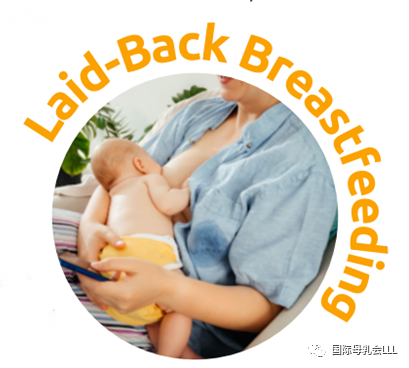
This position allows your body to rest while you feed. It encourages your baby to use her breastfeeding instincts.
Get comfortable. Even little babies get heavy when you are holding them at the breast for hours each day.
●Find a bed or couch where you can lean back and be well supported. Lean back comfortably, like you might be if you were watching television. Laying flat on your back is not helpful for this position.
●Use a footstool to prop up your feet. It helps to raise your lap and take pressure off of your stomach muscles. Or better yet, put your feet up on the couch or bed with a pillow under your knees.
●Have some pillows nearby. Once your baby is comfortably latched, you can tuck pillows under your arms or elbows. Supporting your arms allows your shoulders and neck to relax.
●Support your head. You can use a pillow or the back of the couch.
Ensure full body contact. If your baby feels completely secure, he will be able to focus on feeding. If he feels insecure, he may wave his arms around or kick his feet in an attempt to hang on to you.
●The laid-back breastfeeding position uses gravity to hold your baby close.
●This position molds his body to your body. It allows your baby to feel safe and secure, knowing that he is not going to fall.
●It is important that the whole front of your baby’s body has full contact with the front of your body. This means that your baby’s chin, tummy, and legs should be in contact with your body.
●Your baby can rest on you in any direction you both like, as long as his front is next to your front. Your baby could lie with his feet down towards either one of your thighs. Or he could be across your body with his feet under your other breast.
●Most babies do not like their feet dangling. It is helpful to provide your baby with somewhere to plant his feet. For example, your baby’s feet could rest on your belly, legs or a pillow.
●When you are in position, your baby’s cheek should rest somewhere near your bare breast.

Adjust your breast as needed. It is important for you to have your breast in a place that allows you to rest comfortably while feeding. The following may be helpful:
●Use your upper arm to secure your breast so the nipple does not fall to the side of your body.
●Hold your breast while your baby latches.
●Release your breast once your baby has latched deeply and started sucking. You may need to move a little to get into a more comfortable position.
●Bring your baby to your breast rather than moving your breast to your baby.

Other breastfeeding positions
There are other breastfeeding positions you may want to use in the early days. Some are easier once you and your baby are experienced at nursing. Remember, if one position is not working for you, try another one.
Cross-cradle hold. The cross-cradle position can be useful in the early days. It gives you more control over the position of your baby and your breast. It is a common hold used when latching a premature or small baby. Once your baby is latched it can be helpful to switch your arms to the cradle position.

●Hold your baby in the opposite forearm from the breast you are using.
●Place your baby’s bottom near the crook of your arm.
●Use your forearm to support your baby’s back.
●Support your baby’s head with your hand. Your thumb and fingers will be at the base of the neck and your palm at the upper back.
●Use your other hand, if you need to support your breast or want to use the exaggerated latch technique.
●Make sure that your baby is turned tummy to tummy with you.
●Give your baby a gentle push between the shoulder blades with the palm of your hand as he latches. This will bring your baby close. Continue to hold him close so he doesn’t fall off when he sucks.
●Lean back or use pillows to take some pressure off of your arm. This helps your baby feel secure.
●Avoid holding the top of your baby’s head. This can trigger your baby to pull away from the breast.
Football or Clutch hold. This hold can be helpful if you have had a cesarean birth. It keeps your baby away from your incision. It can also be helpful if you have larger breasts. You can feed two babies at the same time in a double football hold.
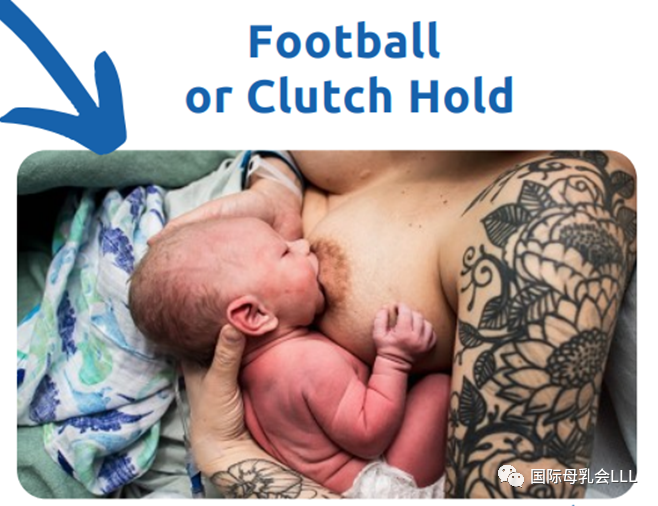
●Hold your baby’s front against the side of your body.
●Use your forearm to support your baby’s back. Your hand is at the base of your baby’s head. Your baby’s feet are near the back of your body.
●Use your elbow to tuck your baby in close to you.
●Ensure that your baby is far enough back that she latches with her chin first and her nose tipped away (see “Getting a Good Latch” below).
●If needed, place a cushion between your back and the back of the chair or sofa. Otherwise your baby’s feet may push away. If your baby is too far to the front, your baby’s chin will tuck into her chest causing a shallow latch.
Cradle hold. This position may be difficult to master in the early days and weeks but once you are experienced at breastfeeding, it will likely become a regular position for you.

●Cradle your baby in the forearm on the same side as the breast you are using. Use your opposite hand to lift or adjust your breast.
●Turn your baby toward you so that his tummy is touching your tummy.
●Continue to hold your baby close as he reaches up to latch. This will help make sure that he does not fall off the breast when he sucks. If you are sitting upright, it can be tiring to hold your baby close enough that he feels secure. (Think about how close he would be if he was laying on top of you. That’s how close he needs to be against your body.)
●Lean back to take some pressure off of your arm.
●Have pillows nearby to put under your arms once your baby is latched. This can help take the strain off of your arms, shoulders and neck. A nursing pillow may be helpful to support your baby’s body.
Side-lying position. The side-lying position is helpful if you are recovering from a cesarean birth or if your bottom is sore after giving birth. It is also extremely helpful for breastfeeding in bed during the night. This position can be a little tricky to master because you have limited use of the arm you are lying on. It is worth practicing as soon as possible so you can nurse lying down. Once you get the hang of it, it makes nighttime and naptime nursing much easier.
For more information on sleeping safely with your baby in your bed see Safe Sleep and Breastfeeding Baby.

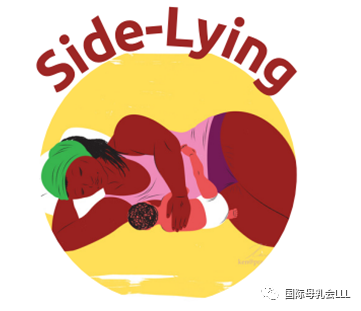
●Lie on your side with your knees bent up and a pillow under your head.
●Place your baby on his side facing you with his head on the bed.
●Make sure your baby’s nose is level with your nipple. Adjust how you are lying so your nipple is as far away from the bed as your baby’s mouth.
●Place your arm under your baby’s head if needed to get your nipple opposite your baby’s nose.
●Give your baby a gentle push between the shoulder blades with the palm of your hand, as she latches. This helps bring your baby close.
●Remember to bring your baby in chin first, with her head tipped back and her nose off the breast.
●Use one hand or temporarily prop yourself up on your elbow while latching. Propping yourself allows you to also use your lower hand to latch. Once your baby is comfortably latched you can lower yourself back down onto the bed.
●Use a pillow between your knees for comfort.
●Place a pillow under the small of your back to prevent you from rolling onto your back.
Videos You May Find Helpful
For the laid-back position:
https://www.biologicalnurturing.com/sample-of-biological-nurturing/
For latching and good feeding at breast: https://ibconline.ca/breastfeeding-videos-english/



参考资料
www.lllc.ca/sites/default/files/Positioning%20and%20latching.pdf

END
译者 | 传艳
审阅 | Lynn & Marien
编辑 | 李热爱

找到我们
微信公众号|视频号|小红书|抖音|新浪微博|今日头条|哔哩哔哩|腾讯视频|优酷
搜索关键字“国际母乳会LLL”


更多阅读资料,
欢迎大家访问“国际母乳会LLL”官网:
https://www.muruhui.org/
分享
收藏
点赞
在看

本篇文章来源于微信公众号: 国际母乳会LLL
